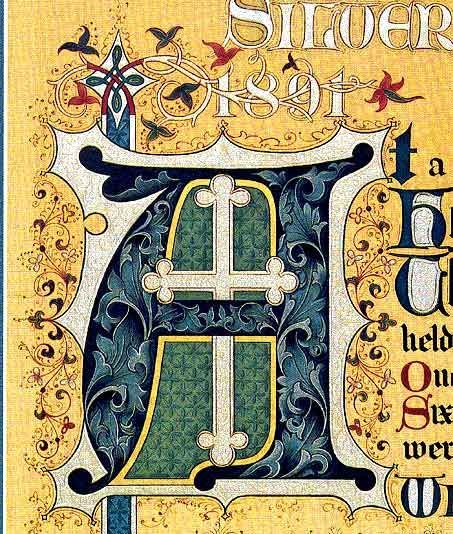Recreating historical items. Handmade scrolls, textiles, jewelry, blacksmithing, wood carving, bead making, and armoring. If it existed during the medieval period, chances are that someone is recreating it.
Scribal Arts in the SCA: Illuminating History
Within the vibrant tapestry of the SCA's Arts and Sciences, the Scribal Arts stand out as a uniquely beautiful and historically rich pursuit. This discipline brings to life the painstaking artistry of medieval and Renaissance scribes, illuminators, and calligraphers, recreating the exquisite beauty of historical manuscripts and documents.
SCA scribes delve deep into the methods and materials of the past, learning to transform simple parchment or paper into stunning works of art. This isn't just about copying; it's about understanding the craft:
- Calligraphy: Mastering various historical hands, from the elegant Carolingian minuscule to the ornate Gothic textura, and the flowing Italic scripts of the Renaissance. Scribes learn how to properly prepare ink, cut quills, and control their strokes to achieve authentic letterforms.
- Illumination: Beyond just letters, this involves the intricate decorative elements that adorn historical manuscripts. Scribes learn techniques for applying vibrant pigments, often made from historical recipes, and the delicate art of gold leafing to create shimmering borders, initial letters, and miniature paintings. This can include understanding iconography, historical motifs, and color palettes.
- Pigment Making: Some dedicated scribes even go further, researching and grinding their own historical pigments from minerals, plants, and other natural sources, just as medieval artists would have.
- Scroll Production: The ultimate goal for many scribes is the creation of scrolls – beautiful, hand-lettered and illuminated documents often used as awards within the SCA. These can range from simple charters to elaborate, multi-page works of art, each a testament to the scribe's skill and dedication.
The Scribal Arts offer a meditative and highly rewarding creative outlet. It requires patience, precision, and a deep appreciation for the aesthetic and historical significance of written works. Whether you're drawn to the elegant flow of a well-formed letter, the vibrant glow of gold leaf, or the rich history encapsulated in ancient texts, the SCA's Scribal Arts provide a direct connection to the beauty and intellectual life of the past. Come discover the joy of illuminating history, one stroke at a time!
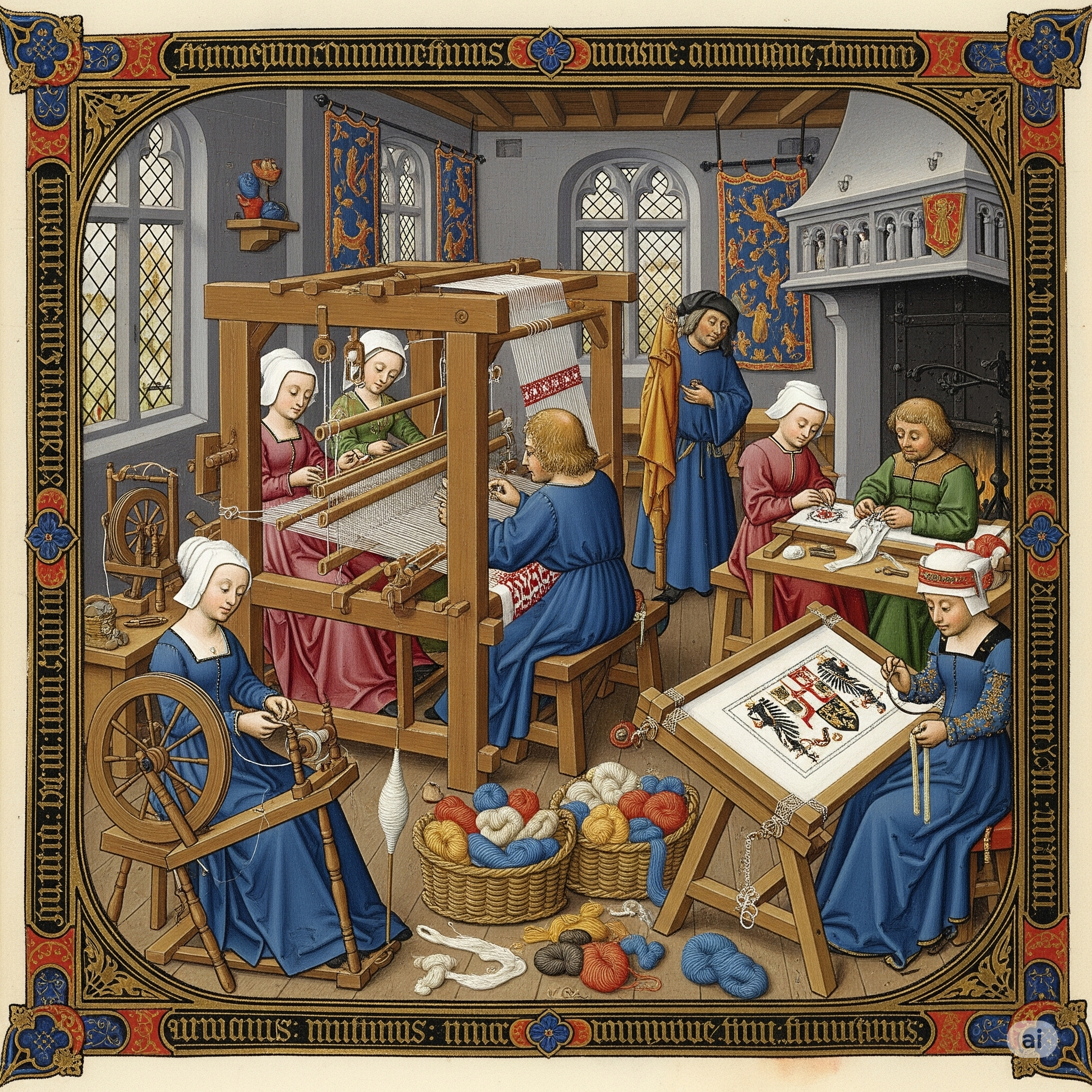
Fiber Arts in the SCA: Weaving History Together
Step into the intricate world of Fiber Arts within the Society for Creative Anachronism (SCA), where the rich history of textiles, clothing, and needlework comes alive. This vibrant area of the Arts and Sciences allows participants to explore and recreate the countless ways our ancestors worked with fibers to create beauty, utility, and warmth.
SCA fiber artists are dedicated to researching and practicing historical techniques from diverse cultures and periods, breathing life into forgotten crafts. Whether you're drawn to the raw materials or the finished garment, there's a fascinating journey awaiting:
- Spinning: Transform raw wool, flax, silk, or other fibers into usable thread using period tools like drop spindles and spinning wheels. Learn to process fibers from their natural state, understanding the nuances that create different types of yarn.
- Dyeing: Discover the vibrant palette of the past by extracting natural dyes from plants, insects, and minerals. Learn historical mordanting techniques to fix colors onto fibers, recreating the rich hues found in surviving historical textiles.
- Weaving: Create fabrics on looms, from simple tablet weaving used for decorative bands to complex patterns on larger looms, replicating the textures and patterns of historical cloth.
- Knitting & Nalbinding: Explore various methods of creating fabric from yarn. Nalbinding (or needle-binding) is an ancient technique predating knitting, often used for socks and hats, while historical forms of knitting create period garments like caps and stockings.
- Sewing & Garment Construction: Learn to hand-sew or use period-appropriate machine techniques to construct historically accurate clothing. This involves researching patterns, understanding period fashion, and meticulously crafting garments that reflect different eras and social standings.
- Embroidery & Needlework: Adorn textiles with stunning decorative stitches. From complex silkwork and goldwork to practical mending techniques, learn the intricate art of historical embroidery that elevated clothing and household items to works of art.
- Braiding & Cordage: Master techniques like lucet braiding, fingerloop braiding, or plaiting to create decorative cords, laces, and functional ropes.
Fiber Arts in the SCA offer a tangible connection to daily life in the Middle Ages and Renaissance. It's a rewarding pursuit that combines meticulous research, skilled handiwork, and a deep appreciation for the ingenuity of historical artisans. Come join us and discover the satisfying process of bringing historical textiles and garments to life, thread by thread.
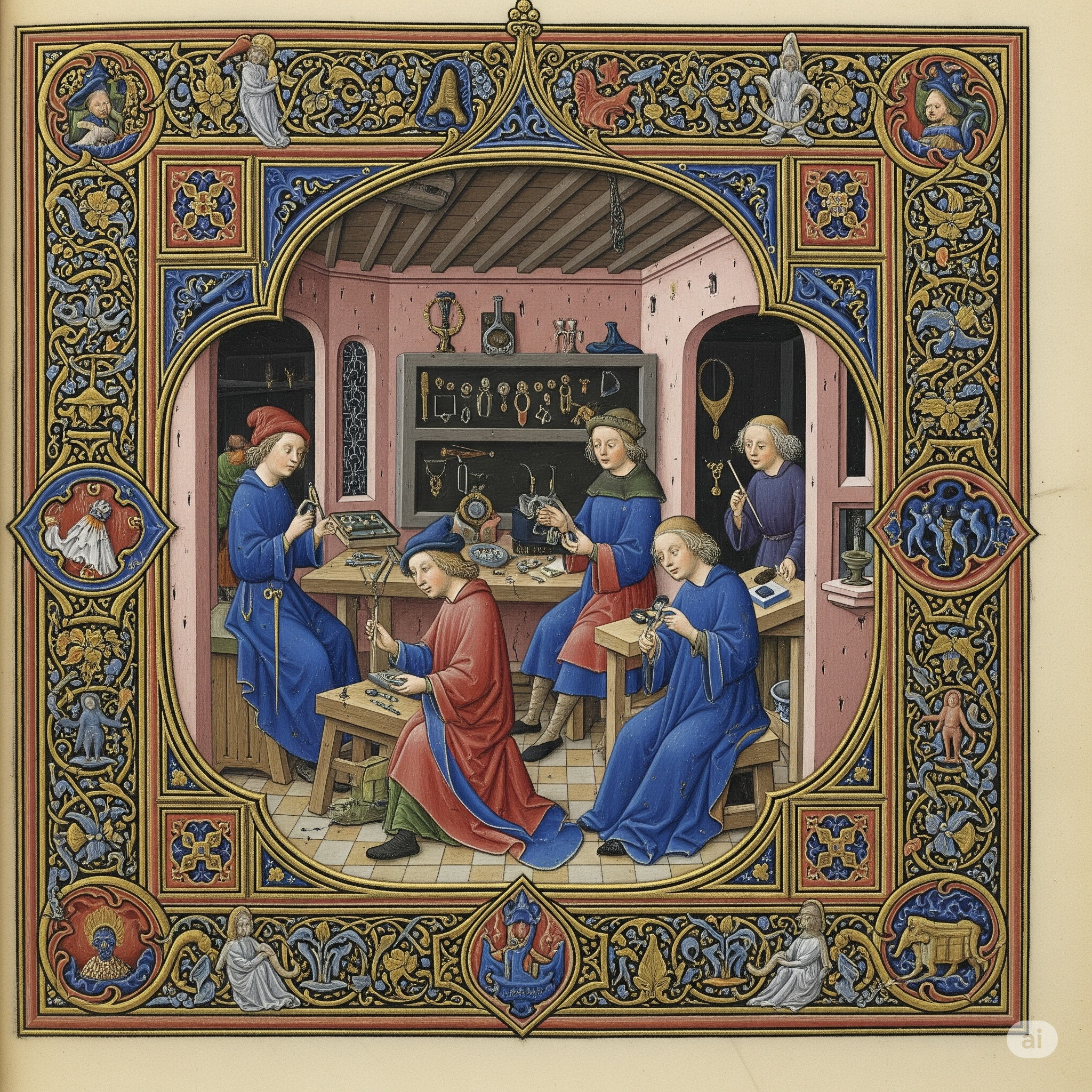
Jewelry and Glass Work in the SCA: Adorning History
Within the vibrant tapestry of the SCA's Arts and Sciences, Jewelry and Glass Work offers a captivating dive into the ancient crafts of adornment and material transformation. This area allows participants to explore and recreate the beautiful and often intricate pieces that graced people, homes, and sacred spaces throughout the Middle Ages and Renaissance.
SCA artisans dedicated to jewelry and glass work delve into historical techniques, tools, and materials to understand how these exquisite items were made centuries ago. It's a journey that combines artistic vision with technical precision:
Jewelry Making:
- From simple wirework to complex casting and stone setting, artisans explore a wide array of historical jewelry techniques. This can include:
- Filigree and Granulation: Creating delicate patterns with fine wires or tiny beads of metal.
- Repoussé and Chasing: Hammering metal from the back to create a raised design, then refining it from the front.
- Enameling: Fusing powdered glass onto metal to create vibrant, durable decorations.
- Casting: Pouring molten metal into molds to create intricate shapes, such as brooches, pendants, and rings.
- Gemstone Cutting and Setting: Researching historical cuts and setting styles for precious and semi-precious stones.
- Wirework: Twisting, bending, and shaping wire to create chains, clasps, and decorative elements.
- Viking Age and Early Medieval Jewelry: Recreating specific styles like twisted wire torcs, intricately patterned brooches, and bead necklaces.
- Renaissance Jewels: Exploring more elaborate, gem-encrusted pieces reflecting the wealth and fashion of the period.
Glass Work:
- This field explores the historical methods of shaping and decorating glass, from practical vessels to decorative beads and stained glass:
- Lampworking/Beadmaking: Using a torch to melt glass rods and winding the molten glass onto a mandrel to create individual beads, often adorned with intricate patterns. This is a common entry point for glass work in the SCA.
- Stained Glass: Learning historical techniques of cutting colored glass, assembling pieces with lead came, and soldering them to create stunning windows and decorative panels.
- Blown Glass: While more complex and requiring specialized equipment, some advanced artisans explore historical glass blowing techniques to create vessels and other forms.
- Fusing and Slumping: Melting and shaping glass in a kiln to create flat or molded pieces.
Safety is paramount in both jewelry and glass work, with a strong emphasis on proper ventilation, personal protective equipment, and careful handling of tools and materials.
Jewelry and Glass Work in the SCA offers a tangible connection to the material culture of the past, allowing participants to wear, display, and even gift pieces that truly reflect historical artistry. It's a rewarding pursuit that combines scientific understanding of materials with artistic expression. Come discover the joy of creating enduring beauty with metal and glass!
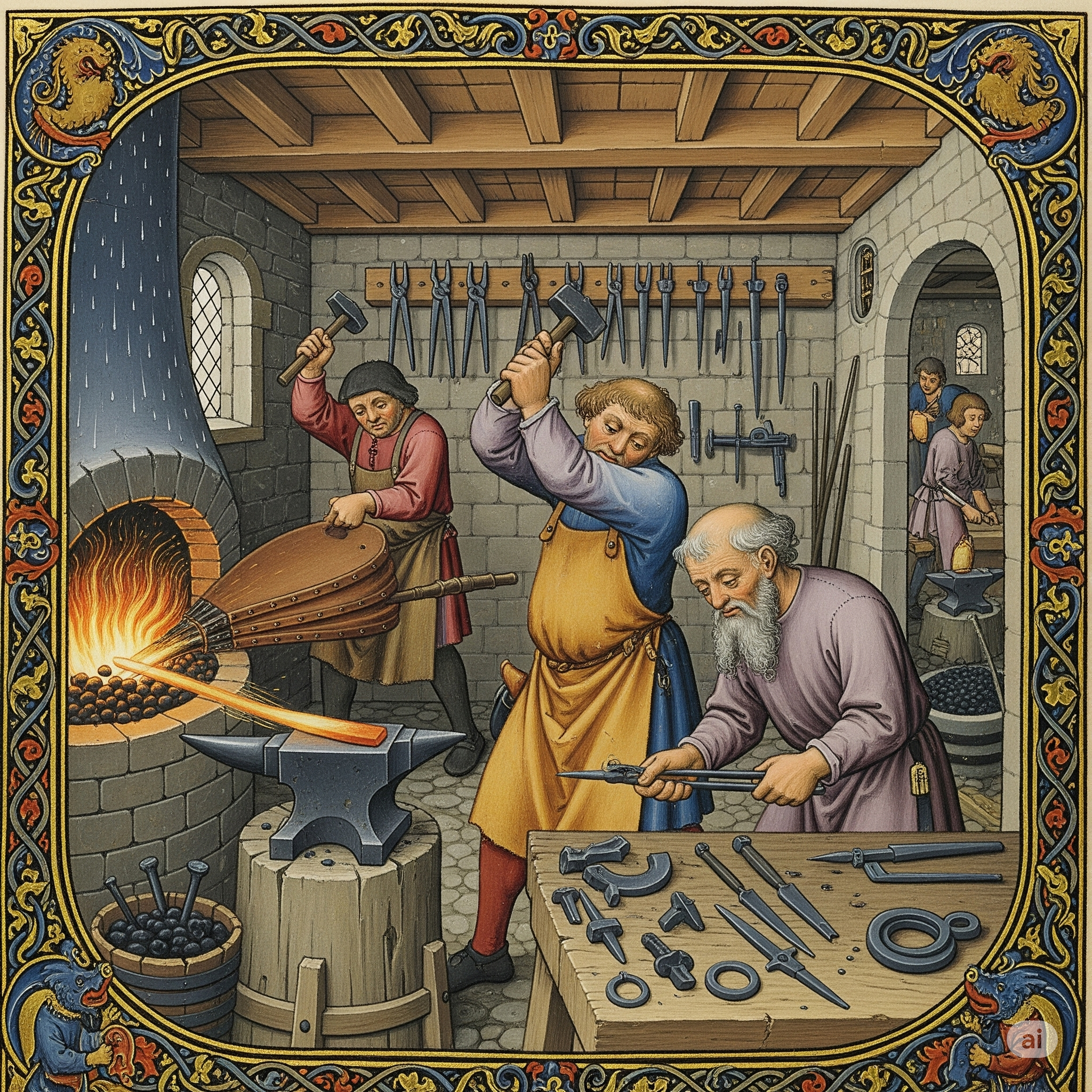
Blacksmithing in the SCA: Forging History
Feel the heat of the forge and the rhythm of the hammer as you delve into Blacksmithing within the Society for Creative Anachronism (SCA). This foundational medieval craft is a cornerstone of the Arts and Sciences, allowing participants to directly experience the transformative power of fire and steel, just as artisans did for centuries.
SCA blacksmiths are dedicated to researching and recreating the tools, techniques, and products of pre-17th-century metalworkers. From humble everyday items to impressive pieces of armor and weaponry, blacksmithing connects us to a vital historical trade:
- The Forge and Fire: Learn to manage a charcoal or coal forge, understanding how to achieve and maintain the precise temperatures needed to make steel pliable. This involves mastering the bellows and controlling the airflow.
- Hammers and Anvils: Develop proficiency with a variety of hammers, learning different striking techniques to shape hot metal on the anvil. The rhythmic "ring" of the hammer on steel is a quintessential part of the blacksmithing experience.
- Fundamental Techniques: Practice core blacksmithing skills such as:
- Drawing Out: Lengthening metal by hammering.
- Upsetting: Thickening metal by hammering it back on itself.
- Bending and Twisting: Shaping metal into various forms.
- Punching and Drifting: Creating holes and shaping them.
- Welding: Joining pieces of hot metal together.
- Historical Tools & Products: Recreate a wide range of period items, which can include:
- Household Items: Hooks, latches, hinges, cooking implements, candle holders.
- Tools: Chisels, punches, tongs, and other implements for various crafts.
- Weapon Components: Dagger blades, sword fittings, spearheads, arrowheads (for display or specific SCA combat forms where permitted and safe).
- Armor Components: Creating buckles, rivets, and sometimes even pieces of plate armor itself.
- Decorative Ironwork: Gates, grilles, and other architectural elements.
- Material Science: Gain a practical understanding of how different types of steel behave under heat and hammer, and how to temper and harden finished pieces to achieve desired properties.
Safety is paramount in blacksmithing. Participants learn rigorous safety protocols for handling hot metal, operating tools, and working around the forge, always under the guidance of experienced instructors.
Blacksmithing in the SCA is a physically engaging and incredibly rewarding pursuit. It offers a tangible connection to the ingenuity of historical craftsmen and the satisfaction of transforming raw material into functional or artistic objects with your own hands. Come join us and discover the timeless magic of forging steel!
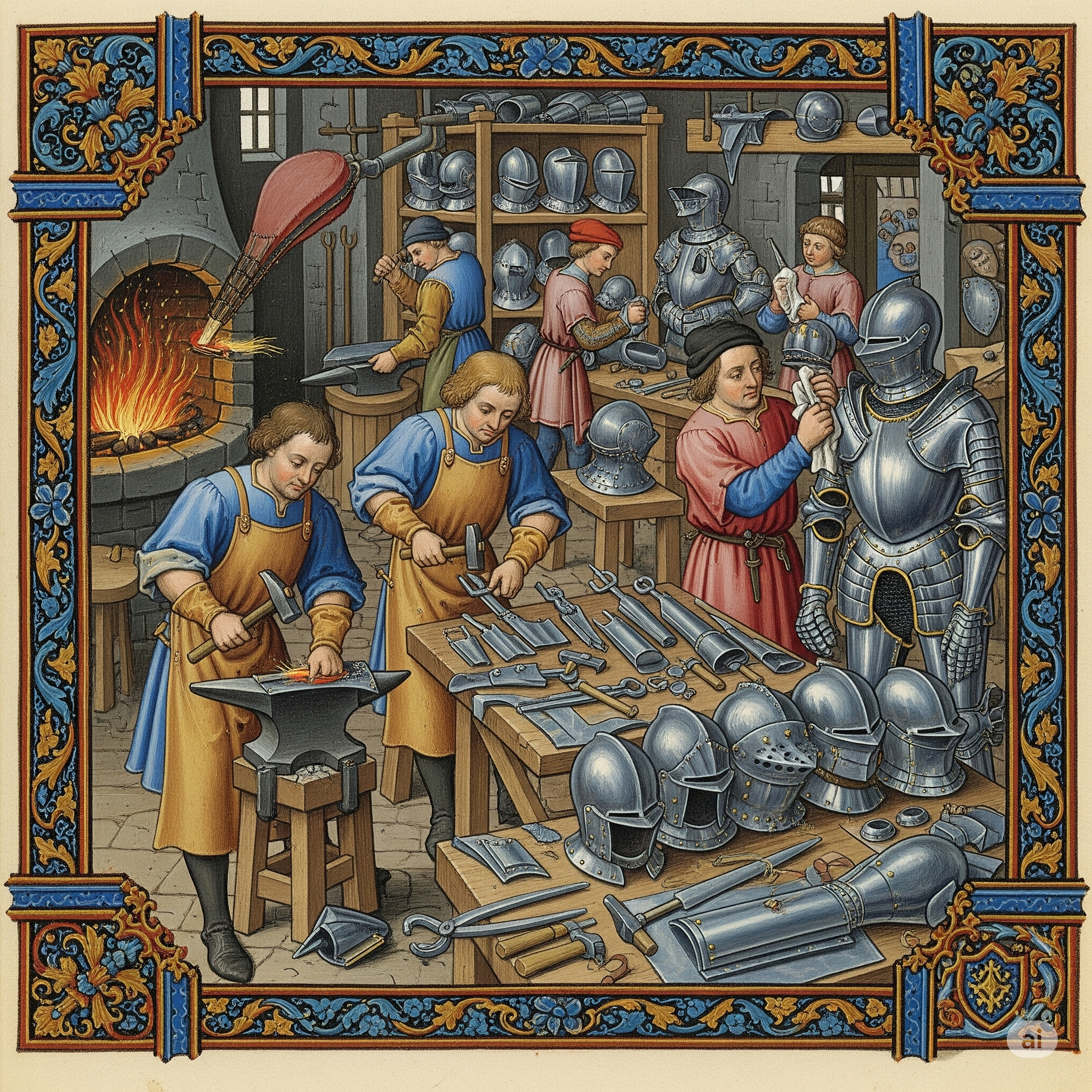
Making Your Own Armor in the SCA: Crafting Protection, Forging History
For those drawn to the iconic image of the knight or warrior, the SCA offers the incredibly rewarding pursuit of making your armor. This intricate and demanding craft is a significant part of the Arts and Sciences, combining historical research, engineering principles, and skilled metalwork or leatherwork to create the protective gear worn in our various combat activities.
SCA armorers are dedicated to understanding and replicating the methods used by historical armorers from across the Middle Ages and Renaissance. It's a journey into form, function, and historical accuracy:
- Research and Design: The process begins with extensive research into historical armor styles, construction methods, and materials relevant to your chosen period and persona. This involves studying effigies, extant pieces in museums, and historical illustrations to ensure authenticity.
- Materials:
- Steel: The most common material, typically mild steel, stainless steel, or hardened steel. Armorers learn about different gauges (thicknesses) and their suitability for various armor components.
- Leather: Often used for internal strapping, articulation, or as the primary material for brigandine and cuir bouilli (hardened leather) armor.
- Other Materials: Rivets, buckles, straps, padding materials, and even chainmail rings are all part of the construction.
- Tools and Techniques: Armoring involves a specialized set of tools and a deep understanding of metal properties:
- Raising and Sinking: Using hammers and stakes to shape flat sheets of metal into complex curves for helmets, breastplates, and limb defenses.
- Fluting and Ridging: Adding decorative and strengthening elements through specific hammering techniques.
- Cutting and Forming: Precisely cutting metal blanks and forming them to fit the body.
- Heat Treating: For advanced armorers, understanding how to harden and temper steel for improved strength and resilience.
- Assembly: Drilling, riveting, welding (for modern construction elements), and creating intricate strapping systems to ensure the armor moves with the wearer and provides maximum protection.
- Articulations and Ergonomics: A key challenge is creating armor that is both protective and allows full freedom of movement for combat. This involves designing complex articulated joints for elbows, knees, and shoulders.
- Safety Standards: All armor made for SCA combat must meet rigorous safety standards, ensuring that it provides adequate protection against the impacts of rattan, steel, or other combat forms. Armorers learn these standards and incorporate them into their designs.
Making your armor is a deeply satisfying endeavor, culminating in a functional work of art that not only protects you in combat but also connects you directly to the skills and ingenuity of historical artisans. It requires patience, precision, and a willingness to learn, but the result is a truly unique and historically authentic piece that you can be proud to wear into battle or display as a testament to your craft. Come experience the satisfaction of forging your own defense!
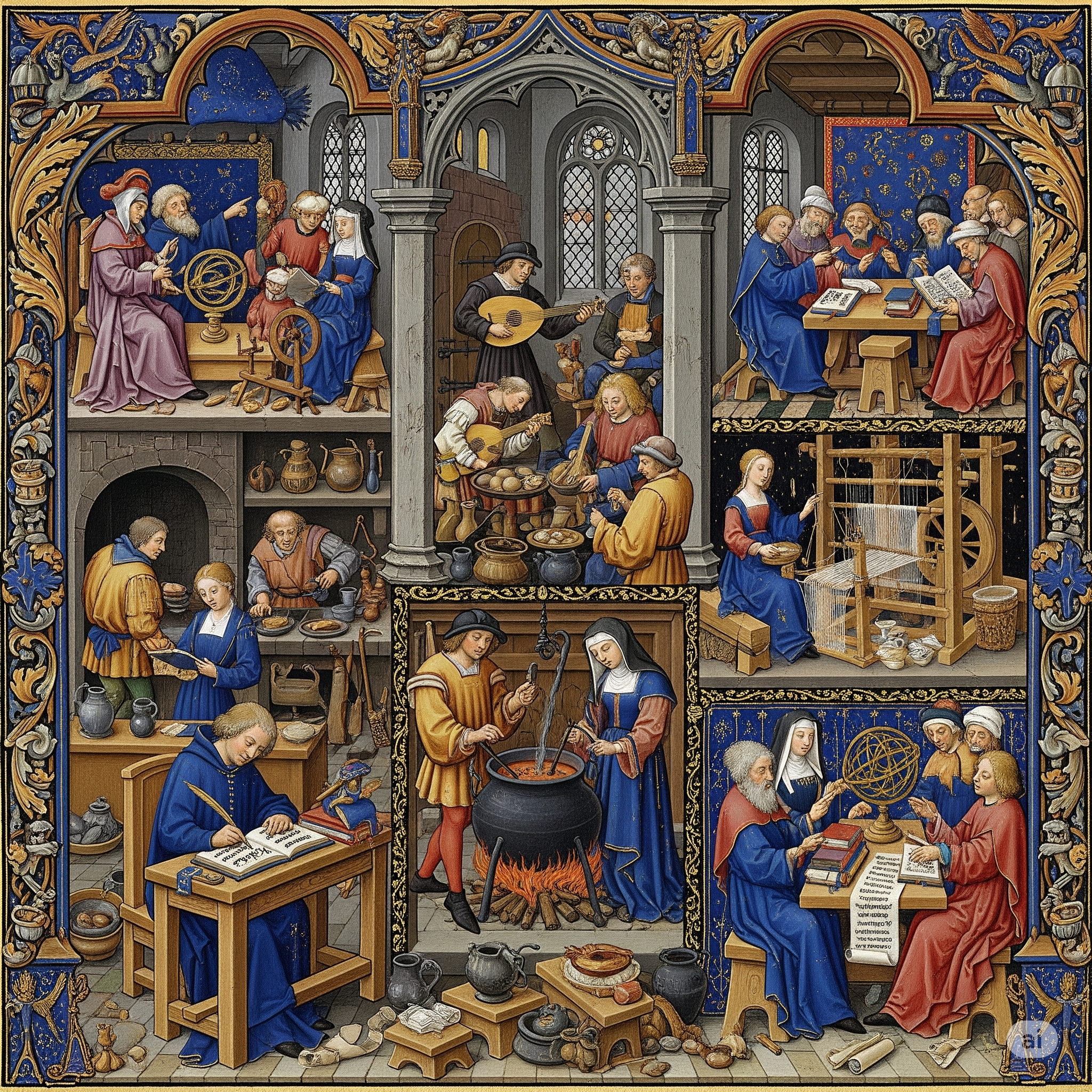
The Broader World of Arts & Sciences in the SCA: Endless Exploration
While the clang of the blacksmith's hammer, the delicate touch of a scribe's quill, the intricate weave of a loom, and the sparkle of a crafted jewel are core to the SCA's Arts and Sciences, they represent only a fraction of the incredible breadth of creativity and historical exploration on offer. Beyond these well-known crafts lies a nearly endless array of disciplines, inviting you to delve into every facet of pre-17th century life.
The "everything else" in SCA A&S covers the daily lives, entertainment, intellectual pursuits, and practical skills of the Middle Ages and Renaissance. If it existed and was created before 1600 CE, chances are someone in the SCA is researching it, recreating it, or teaching it!
Consider just some of the other captivating areas you can explore:
- Culinary Arts: Savor the past by researching, cooking, and feasting on historical recipes. Learn about period ingredients, cooking methods, food preservation, brewing mead or ale, and the dining customs of different eras.
- Music and Dance: Transport yourself with the sounds and movements of history. Learn to play period instruments (lute, harp, recorder, pipe and tabor), study historical compositions, or master the steps of medieval court dances and lively country dances.
- Leatherworking (Beyond Armor): Craft beautiful and functional items like pouches, belts, shoes, scabbards, book bindings, and decorative boxes using traditional tools and techniques.
- Woodworking: From carving intricate details on furniture to crafting useful household items, bowls, or even period games, discover the diverse world of historical woodworking.
- Ceramics and Pottery: Explore various forms of historical pottery, learn to work with clay, glaze, and fire pieces using methods inspired by historical potters.
- Bardic Arts: Bring stories, poetry, and songs of the past to life. Develop skills in historical performance, storytelling, recitation, and composing new works in period styles.
- Games and Pastimes: Learn and play the recreational activities of our ancestors, from board games like Chess and Hnefatafl, to dice games, and outdoor pursuits.
- Scientific and Scholarly Pursuits: Research and recreate historical science, mathematics, navigation, cartography, philosophy, medicine, and engineering. Conduct deep historical research into any topic that sparks your interest.
- Household Arts: Delve into historical domestic life, including candlemaking, soapmaking, historical cleaning techniques, and the management of a medieval or Renaissance household.
The beauty of these "other" Arts and Sciences lies in the freedom to follow your passion. It's a journey of discovery, learning, and sharing, all within a supportive community dedicated to excellence and historical authenticity. If you have an interest in how people lived, created, and thought in the pre-17th century world, the SCA's vast and inclusive Arts and Sciences program has a place for you to learn, grow, and bring history to vibrant life.
